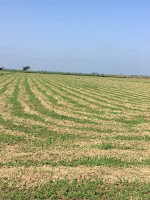Hay is the best season to make dry fodder
If you have never made hay dry fodder before, nowadays you can make a small amount of grass on an experimental basis with a small amount of grass on a marla lozenge, alfalfa or oat fodder.
The weather will be clear in most parts of the country, such weather is perfect for hay If the sun shines in your area for the next 4-5 days, you can make hay. The weather should be clear whenever it happens This post is for those who have never made hay dry fodder and want to make it The description of hay is in the pictures in the post, see all the pictures in the post Drying the green fodder so that the amount of water in it is less than 10%, it is called hay or dry fodder. There is a way to preserve hay fodder in such a way that it does not affect the nutrition of the fodder.
Dry fodder is equally good for all animals.?
For young children, for fattening meat animals, even in the first few weeks of fresh sleep and before bedtime, when the animal's diet is reduced after an illness. Dry fodder is very good on such occasions.
There are two ways to make all the pictures of the post look in the pictures of the post. Choose the method you like best, easy. Experiment with both, and choose the one that suits you best Be careful not to lose the leaves as the real nutrition is in the leaves On very hot summer days, the quality of hay decreases, so today is the best season.
The next day, the biggest problem is mould or fungus which is caused by the fodder not getting air and light. Try not to make the layer of cut fodder too thick. No problem. God willing
If you haven't already, make a small amount as an experiment. Our farmers are not afraid of experience but they are afraid of what people say, so experiment a little
Any good protein food, whether it is Wanda or fodder, increases the animal's thirst or need for water, so water is always available to the animal.
Farmers who make hay are requested to post pictures of their hay in the comments so that other farmers can see you and get guidance and learn. The pictures in the post are of farmers like you Cut and dry more fodder to preserve nutrition. There is no difference between the nutrition of green and dry fodder cut at the right time.
Harvesting of fodder at the right time
Overcooked fodder reduces nutrition and at the same time reduces digestibility. Fertilizer, water and land use are also wasted, fodder efficiency and digestion rate are reduced which affects animal production.
The solution to avoid these things is to dry oats, lucerne, alfalfa, rhododendron grass and make hay (dry fodder). If the fodder is cut prematurely, the yield of fodder per acre is reduced.
Oats, barley and wheat are the same plants, do green oats, barley and wheat bran have the same nutrients? Oats and barley fodder contain 12-10% protein and dry wheat bran contains only 3.2% protein. So use fodder when nutrition is high.
You yourself understand the difference between the nutrition of dried lucerne and dried toddy. When you add fresh fodder of lucerne and algae, doesn't the milk of the animal increase ?? What if they eat the same fodder and silage all year round?
Crude protein is 19-22% in dry lucerne, 14% in dry rods grass and only 3% in toddy.
The pictures included in the post are written in Urdu, the answers to the questions are included in this post and the pictures.









0 Comments